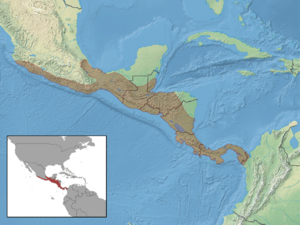Sumichrast's vesper rat facts for kids
Quick facts for kids Sumichrast's vesper rat |
|
|---|---|
 |
|
| Nyctomys sumichrasti | |
| Conservation status | |
| Scientific classification | |
| Genus: |
Nyctomys
|
| Species: |
sumichrasti
|
 |
|
The Sumichrast's vesper rat (Nyctomys sumichrasti) is a type of rodent. It belongs to the family Cricetidae, which includes many kinds of mice and rats.
These rats live in an area stretching from southern Mexico all the way to Panama. They are named after François Sumichrast, who was the first person to collect a specimen of this animal. Its closest relative is likely Hatt's vesper rat, which is a bit smaller and lives in the Yucatán Peninsula.
What They Look Like
Sumichrast's vesper rat is a fairly small rodent. An adult rat is usually about 10 to 13 cm (3.9 to 5.1 in) long. This measurement does not include its tail, which is only a little bit shorter than its body.
Both male and female rats are about the same size. They usually weigh between 220 to 245 g (7.8 to 8.6 oz). These rats are known for their bright colors. Their backs are often reddish or orange, and their bellies are creamy white.
They have thick, soft fur that covers their whole body, even their tail. Only the bottoms of their feet are bare. Sumichrast's vesper rats have large eyes with a thin ring of black fur around them. They also have long whiskers and small ears.
Their claws are curved and pressed flat, which helps them climb. The first toe on each foot is shaped like a thumb. This special toe also helps them grip branches when climbing trees.
Where They Live
You can find Sumichrast's vesper rats from southern Jalisco and Veracruz in Mexico. Their home range extends through most of Central America, but not the Yucatan area. They live as far east as central Panama.
These rats prefer to live in evergreen and semi-deciduous forests. You can find them at different heights, from sea level up to 1,600 m (5,200 ft) high in the mountains.
Scientists recognize nine different types, or subspecies, of Sumichrast's vesper rat:
- N. s. sumichrasti - found in southern Veracruz, Mexico
- N. s. colimensis - found from Jalisco to Oaxaca, Mexico
- N. s. costaricensis - found in southern Costa Rica
- N. s. decolorus - found in southern Belize and eastern Guatemala to Honduras
- N. s. florencei - found in southern Honduras and western Nicaragua
- N. s. nitellinus - found from eastern Costa Rica to central Panama
- N. s. pallidulus - found in southern Tabasco and western Chiapas
- N. s. salvini - found in eastern Chiapas and southern Guatemala
- N. s. venustulus - found in eastern Nicaragua
How They Live
Sumichrast's vesper rats are quite special because they are arboreal. This means they mostly live in trees. They build their nests from twigs and leaves high up in the forest.
These rats rarely travel on the ground. They prefer to stay in the middle and upper parts of the forest, usually between 3 and 22 m (9.8 and 72.2 ft) high. They build their nests inside hollow trees or in the forks of branches. Their nests are messy piles of material with a hollow space in the middle, about 10 cm (3.9 in) wide. They often build new nests on top of old ones, creating many layers over time.
Sumichrast's vesper rats are nocturnal, meaning they are active at night. They are also herbivorous, which means they eat plants. Their diet mainly consists of fruits and seeds. They have also been seen eating a few moths.
Some of their favorite foods include figs and seeds from plants like Jacquinia pungens and borage. In Costa Rica, they have even been seen eating the poisonous leaves of a plant called Daphnopsis americana. However, they are careful to avoid the center of the leaf and only pick young leaves.
These rats follow the same paths along branches when they search for food. Their home range is usually about 70 m (230 ft) across. While they move slowly on the ground and when they are eating or cleaning themselves, they are very quick and nimble in the trees. They constantly twitch their whiskers and ears as they move.
When kept in a laboratory, these rats stay in family groups with a mated pair. But they do not like strangers and will often attack them. They have been heard making high-pitched, musical chirps and trills. Male rats sometimes make lower grunts to their mates.
Life Cycle
Sumichrast's vesper rats can mate throughout the entire year. A female rat is pregnant for about 30 to 38 days. After this time, she gives birth to one to three young rats.
Both parents help build the nest where the young are raised. However, the male usually stays outside the nest for the first seven days after the babies are born. When they are born, the young rats are about 8 cm (3.1 in) long. They weigh around 4.5 g (0.16 oz).
At first, the babies are blind and only have a little bit of fur. For most of their first two weeks, they stay attached to their mother's teats. They can start to crawl when they are two days old. They stop drinking their mother's milk at about three weeks of age. Their eyes open when they are between fifteen and eighteen days old.
These rats become old enough to have their own babies at around 75 days old. In captivity, some Sumichrast's vesper rats have lived for up to five years.


